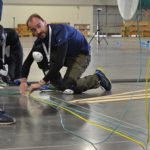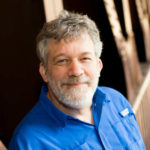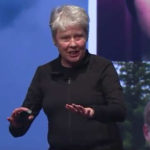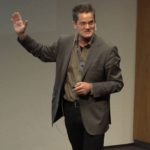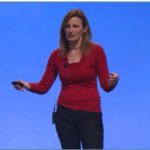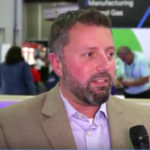At SC17 in Denver, volunteers have already started the installation of SCinet, the high-capacity network that supports the revolutionary applications and experiments that are a hallmark of the SC conference. SCinet takes one year to plan, and those efforts culminate in a month-long period of staging, setup and operation of the network during the conference.
Take Our HPC & AI Survey and Win an Echo Show Device
The rise of AI could potentially spur huge growth for the High Performance Computing market, but what kinds of results are your peers already getting right now? There is one way to find out–by taking our HPC & AI Survey. In return, we’ll send you a free report with the results and enter your name in a drawing to win one of two Echo Show devices with Amazon Alexa technology.
Artificial Intelligence: It’s No Longer Science Fiction
“Computational science has come a long way with machine learning (ML) and deep learning (DL) in just the last year. Leading centers of high-performance computing are making great strides in developing and running ML/DL workloads on their systems. Users and algorithm scientists are continuing to optimize their codes and techniques that run their algorithms, while system architects work out the challenges they still face on various system architectures. At SC16, I had the honor of hosting three of HPC’s thought leaders in a panel to get their ideas about the state of Artificial Intelligence (AI), today’s challenges with the technology, and where it’s going.”
Asetek Achieves 200 Million Hours of Fault-Free Pump Operations at DataCenters
Today Asetek announced that its server pump has achieved 200 million hours of reliable operation in real world use. Installed at end-user locations as diverse as Singapore and Norway, Asetek pumps have run fault-free for the equivalent of 22,000 years. “To date, we have not had a single server pump failure at any of our data center installations around the world,” said Mette Nørmølle, Vice President of Engineering. “Our low-pressure architecture is the key to enabling a cost-effective solution that is relied on by data centers demanding unrivaled performance and maximum uptime.”
Beyond Exascale: Emerging Devices and Architectures for Computing
“Nanomagnetic devices may allow memory and logic functions to be combined in novel ways. And newer, perhaps more promising device concepts continue to emerge. At the same time, research in new architectures has also grown. Indeed, at the leading edge, researchers are beginning to focus on co-optimization of new devices and new architectures. Despite the growing research investment, the landscape of promising research opportunities outside the “FET devices and circuits box” is still largely unexplored.”
Understanding Cities through Computation, Data Analytics, and Measurement
“For many urban questions, however, new data sources will be required with greater spatial and/or temporal resolution, driving innovation in the use of sensors in mobile devices as well as embedding intelligent sensing infrastructure in the built environment. Collectively, these data sources also hold promise to begin to integrate computational models associated with individual urban sectors such as transportation, building energy use, or climate. Catlett will discuss the work that Argonne National Laboratory and the University of Chicago are doing in partnership with the City of Chicago and other cities through the Urban Center for Computation and Data, focusing in particular on new opportunities related to embedded systems and computational modeling.”
Video: Diversity and Inclusion in Supercomputing
Dr. Maria Klawe gave this Invited Talk at SC16. “Like many other computing research areas, women and other minority groups are significantly under-represented in supercomputing. This talk discusses successful strategies for significantly increasing the number of women and students of color majoring in computer science and explores how these strategies might be applied to supercomputing.”
Reflecting on the Goal and Baseline for Exascale Computing
Thomas Schulthess from CSCS gave this Invited Talk at SC16. “Experience with today’s platforms show that there can be an order of magnitude difference in performance within a given class of numerical methods – depending only on choice of architecture and implementation. This bears the questions on what our baseline is, over which the performance improvements of Exascale systems will be measured. Furthermore, how close will these Exascale systems bring us to deliver on application goals, such as kilometer scale global climate simulations or high-throughput quantum simulations for materials design? We will discuss specific examples from meteorology and materials science.”
Parallel Multiway Methods for Compression of Massive Data and Other Applications
Tamara Kolda from Sandia gave this Invited Talk at SC16. “Scientists are drowning in data. The scientific data produced by high-fidelity simulations and high-precision experiments are far too massive to store. For instance, a modest simulation on a 3D grid with 500 grid points per dimension, tracking 100 variables for 100 time steps yields 5TB of data. Working with this massive data is unwieldy and it may not be retained for future analysis or comparison. Data compression is a necessity, but there are surprisingly few options available for scientific data.”
Dell & Intel Collaborate on CryoEM on Intel Xeon Phi
In this video from SC16, Janet Morss from Dell EMC and Hugo Saleh from Intel discuss how the two companies collaborated on accelerating CryoEM. “Cryo-EM allows molecular samples to be studied in near-native states and down to nearly atomic resolutions. Studying the 3D structure of these biological specimens can lead to new insights into their functioning and interactions, especially with proteins and nucleic acids, and allows structural biologists to examine how alterations in their structures affect their functions. This information can be used in system biology research to understand the cell signaling network which is part of a complex communication system.”

